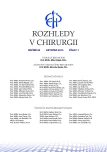Hepatic pseudolesions adjacent to the falciform ligament
Authors:
P. Vávra 1,2,6; M. Vávrová 3; P. Delongová 4; T. Jonszta 5; J. Dvořáčková 4; A. Pelikán 1,2; M. Penhaker 6; J. Nowaková 6; M. Peteja 1,2
; P. Zonča 1,2
Authors place of work:
Katedra chirurgických oborů, LF Ostravské univerzity
vedoucí katedry: doc. MUDr. P. Vávra, Ph. D.
1; Chirurgická klinika, FN Ostrava
přednosta: doc. MUDr. P. Zonča, Ph. D., FRCS
2; Oddělení radiologie a zobrazovacích metod, Nemocnice Nový Jíčín, a. s.
primář: MUDr. M. Velkoborský
3; Ústav patologie, LF Ostravské univerzity a FN Ostrava
přednosta: doc. MUDr. J. Dvořáčková, Ph. D.
4; Ústav zobrazovacích metod, LF Ostravské univerzity a FN Ostrava
přednosta: doc. MUDr. P. Krupa, CSc.
5; Fakulta elektrotechniky a informatiky, VŠB – Technická univerzita Ostrava
děkan: prof. RNDr. V. Snášel, CSc.
6
Published in the journal:
Rozhl. Chir., 2015, roč. 94, č. 11, s. 449-453.
Category:
Souhrnné sdělení
Summary
Introduction:
Accurate detection of hepatic pseudolesions using multi-detector CT and MRI examinations is crucial for the differentiation of benign alterations from primary and secondary malignant lesions in hepatic parenchyma.
Method:
The authors conducted a systematic literature review in PubMed. “Liver“ and “pseudolesion“ were used as keywords in English and Czech, and papers/articles published from 2000 to 2014 were retrieved.
Results:
The authors presented a literature review. In addition, the authors performed a retrospective evaluation of a group of patients treated for liver disease at University Hospital Ostrava where this anomaly was encountered in 7 cases.
In 3 of the patients, diagnostic laparoscopy was done, with visual examination of the lesion accompanied by intraoperative ultrasound exam (IOUS) and partial excision, to establish the diagnosis. Subsequent histological assessment of the specimens confirmed the diagnosis of a steatotic lesion in each of these 3 patients. Additional 2 of the 7 patients underwent liver surgery for concurrent metastatic lesions of colorectal cancer and an open-access revision of the suspected lesions was performed. Visual inspection and intraoperative ultrasound (IOUS) was followed by excisional biopsy. The histology revealed macro- and micro-vesicular steatosis and excluded malignant changes. The last 2 patients still continue to be followed–up regularly on a 6-month routine check-up basis at our hepatology unit.
Conclusion:
The authors presented their own experience gained through inter-disciplinary cooperation at Multidisciplinary conferences. A literature overview of this unusual subject is also included. Particularly in oncologic patients, correct interpretation of these pseudolesions may help to avoid unnecessary biopsies, further imaging examinations and diagnostic laparoscopies and/or explorative laparotomies.
Key words:
pseudolesion − hepatic neoplasm − resection
Zdroje
1. Yoshimitsu K, Honda H, Kuroiwa T, et al. Unusual hemodynamics and pseudolesions of the noncirrhotic liver at CT. Radiographics 2001;21:S81−S96.
2. Spelle L, Soyer P, Rondeau Y, et al. Nontumorous hepatic pseudolesion around the falciform ligament: prevalence on gadolinium chelate-enhanced MR examination. AJR Am J Roentgenol 1997;169:795−9.
3. Macari M, Yeretsian R, Babb J. Assessment of low signal adjacent to the falciform ligament on contrast-enhanced MRI. AJR Am J Roentgenol 2007;189:1443−8.
4. Ucar A, Sahin D, Bulakci M, et al. Prevalence of hepatic pseudolesions around the falciform ligament in a paediatric population. J Int Med Res 2011;39:1490−6.
5. Miscellaneous tumors and tumor-like lesions. In: Saxena R. Practical hepatic pathology: a diagnostic approach. Philadelphia, Saunders 2011:547−63.
6. Prasad SR, Wang H, Rosas H, et al. Fat-containing lesions of the liver: radiologic-pathologic correlation. Radiographics 2005;25:321−31.
7. Torabi M, Hosseinzadeh K, Federle MP. CT of nonneoplastic hepatic vascular and perfusion disorders. Radiographics 2008;28:1967−82.
8. Weerakkody Y, Gaillard F, et al. Focal hepatic steatosis. In: Radiopaedia.org [online]. [cit. 2013-25-04]. Dostupné na: http://radiopaedia.org/articles/focal_fat_infiltration
9. Ihnat P, Vavra P, Rudinska L, et al. Radiofrequency-assisted liver resection: short-term results in a single institution, Bratislavske lekarske listy 2013;114:19−22.
10. Vavra P, Dostalik J, Zacharoulis D, et al. Initial clinical results of a new bipolar radiofrequency ablation device. Conference: International Surgical Congress of the Association-of-Surgeons-in Great-Britain-and-IrelandLocation: Bournemouth, England 2008;52:355−8.
11. Zacharoulis D, Khorsandi SE, Vavra P, et al. Pilot study for a new bipolar radiofrequency ablation/aspirator device in the management of primary and secondary liver cancers. Liver int 2009;29:824−30.
12. Vávra P, Ihnát P, Vávrová M, et al. Hand-assisted laparoscopic liver resection using Habib´s technique: early experience. Wideochir Inne Tech Malo Inwazyjne 2012;7:8−12.
13. El Gendi A, Vávra P, Elkayal E, et al. Radiofrequency assisted hepatic resection: a new technique using a bipolar device. J Hepatol 2010;52:S189.
14. Válek V, Kala Z, Kiss I. Maligní ložiskové procesy jater: diagnostika a léčba včetně minimálně invazivních metod. Praha, Grada 2006.
15. Vávra P. Laparoskopické radiofrekvenčně asistované resekce jater. Banská Bystrica, Marko BB 2013.
Štítky
Chirurgia všeobecná Ortopédia Urgentná medicínaČlánok vyšiel v časopise
Rozhledy v chirurgii

2015 Číslo 11
- Metamizol jako analgetikum první volby: kdy, pro koho, jak a proč?
- Fixní kombinace paracetamol/kodein nabízí synergické analgetické účinky
- Kombinace metamizol/paracetamol v léčbě pooperační bolesti u zákroků v rámci jednodenní chirurgie
Najčítanejšie v tomto čísle
- Hepatální pseudoléze v blízkosti falciformního ligamenta
- Naše zkušenosti s měřením transkutánní tenze kyslíku pro hodnocení prokrvení periferie dolních končetin u pacientů s chronickou ischemickou chorobou dolních končetin
- Resekabilní karcinom pankreatu − 5leté přežití
- Léčba infekce v třísle po tepenné rekonstrukci pomocí podtlakové terapie
